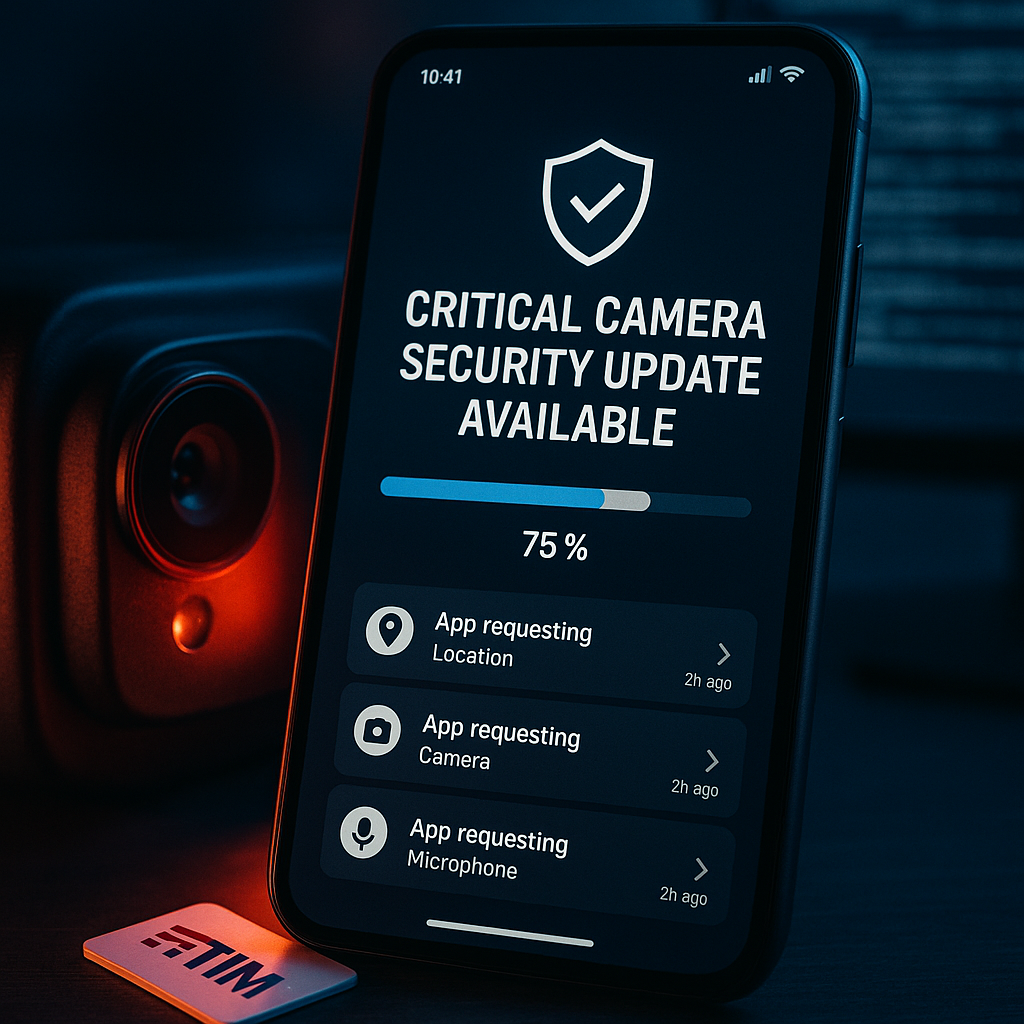Key Takeaways
As we move into 2025, online scams are becoming increasingly sophisticated and technologically advanced, making it more difficult than ever to tell the difference between real and fake digital interactions. With the rise of AI-powered impersonations, hyper-realistic deepfakes, and advanced phishing methods, it’s crucial to refine your defenses. This guide equips you with the tools to recognize fake apps, spot emerging phone scam warning signs, and choose password tools that provide genuine protection in today’s complex digital world.
- AI-powered face-swapping raises the scam stakes: Scammers now use advanced AI to produce hyper-realistic voice and face deepfakes. These are used to impersonate trusted contacts in calls, video chats, and messaging apps. As a result, traditional scam detection methods are far less reliable than before.
- Layered security beats single-tool solutions: Password managers remain essential for generating strong, unique codes, but 2025 demands a more comprehensive defense. Combine leading password tools with identity verification apps, browser security features, and biometric authentication for robust, multi-factor protection.
- Spot fake apps with these warnings: Be cautious of apps from generic developers, those with poor grammar in descriptions, excessive or unnecessary permissions, and those available through speedy downloads outside official app stores. Vet every app before installing and always look for subtle icon differences or typos.
- AI supercharges phone scams using dynamic tactics: Modern scam calls can mimic real voices and use urgent, personalized information gleaned from breaches. Always pause, verify a caller’s identity independently, and never reveal sensitive data under pressure.
- App authorization scams put your accounts at risk: Fraudsters now exploit fake pop-ups and falsified permission requests to access your vaults and accounts. Only grant permissions when absolutely necessary and regularly audit your app connections to block vulnerabilities.
- Browser security tools are now essential: Turn on phishing filters, utilize secure browser modes, and keep browser extensions up to date. Today’s browsers can detect and block many fake login screens and malicious scripts before they compromise your data.
- Question QR codes before scanning in 2025: With QR code phishing on the rise, always preview the URL destination before you scan, especially when codes are found on public signage or sent via unfamiliar messages.
Keeping pace with the latest scam tactics and embracing multi-layered digital security is more important than ever. Now, let’s explore the most authentic scam warning signs for 2025 and the essential password and security tools you need to stay ahead.
Introduction
In 2025, criminals have turned to AI as their go-to tool for crafting scams that are nearly indistinguishable from genuine interactions. Whether through hyper-realistic fake apps or phone scams powered by voice clones and deepfake video calls, these threats are harder to spot and avoid.
To outsmart today’s scams, you need more than just a strong password. Building a layered defense requires sharp instincts, up-to-date tools, and a keen sense of the latest red flags. This guide breaks down how to recognize advanced phishing attempts, fake app warning signs, and the cutting-edge tactics fueling phone scams. You’ll also discover which password and security technologies can truly safeguard your data and peace of mind. Let’s explore the new digital threats of 2025 and the practical steps you can take to secure your digital life.
Un passo avanti. Sempre.
Unisciti al nostro canale Telegram per ricevere
aggiornamenti mirati, notizie selezionate e contenuti che fanno davvero la differenza.
Zero distrazioni, solo ciò che conta.
 Entra nel Canale
Entra nel Canale
The Evolution of AI-Powered Deception
As we look deeper into the landscape of digital scams, it becomes clear that technological advances have shifted the nature of deception. AI-generated content isn’t just a novelty. It now drives some of the most insidious and convincing scam attempts across everyday platforms.
Understanding Modern Deepfakes
AI-powered deepfakes have redefined what’s possible for scammers. No longer limited to editing static images or isolated audio clips, today’s scams involve entire digital personas operating across calls, social media, and even video meetings. For example, a recent Federal Trade Commission report detailed a case in which scammers used AI video impersonations of tech support agents, resulting in more than $12 million in losses in just a quarter.
The hallmarks of these deepfakes include:
- Visually convincing facial movements and natural blinking patterns
- Seamless voice modulation reflecting real accents and emotional tones
- Lifelike conversation pacing, with contextually relevant responses in real time
- Persistent digital presence across multiple channels, mimicking behavioral norms
These trends have surfaced in diverse industries. In finance, AI-powered deepfakes have been used to impersonate executives during sensitive transactions. In healthcare, fraudulent video consultations have been orchestrated to steal patient records. The education sector has also seen fake online tutors using AI to siphon tuition payments, and the retail industry has been targeted by deepfake customer service bots.
Detecting AI Manipulation
Even as AI deception grows more sophisticated, careful users can still spot certain warning signs. These telltale glitches, both visual and auditory, allow attentive individuals to add another critical layer of protection.
Visual Inconsistencies
- Unnatural blinking ratios or delay between blinks
- Minor facial distortions during fluid movements, especially around the mouth and jaw
- Atypical reflections or lighting in the eyes
- Symmetry anomalies during speech
Audio Red Flags
- Background noises that repeat or loop unnaturally
- Irregular response lags or mismatched breathing
- Artificial-sounding word transitions without natural pauses
To counteract these dangers, leading cybersecurity firms are employing multi-factor verification tools that check consistency across platforms and devices. For example, healthcare systems now use biometric cross-checks before telehealth appointments, while financial institutions apply real-time video authentication alongside voiceprint recognition.
This relentless innovation in AI attacks has also shaped the next wave of fake apps, requiring users and businesses across all sectors to stay vigilant.
The Rise of Sophisticated Fake Apps
Fraudulent applications present a growing risk, not just in the tech and banking sectors but also for consumers seeking routine services in healthcare, e-commerce, education, and other fields. The fake app ecosystem has become more elaborate, using clever subterfuge to bypass traditional security.
Warning Signs of Fraudulent Applications
A comprehensive analysis of over 10,000 fake apps revealed patterns common across platforms:
- Suspicious Permission Requests: Apps demanding access to device settings, location tracking, or network data without a clear functional reason. Healthcare apps, for instance, should not require full contact list access; finance tools don’t need camera permissions unless linked to specific features.
- Impersonation Tactics: Imitating legitimate brands with subtle spelling tweaks, similar icons, or cloned design layouts
- Lack of Transparency: Missing developer details, generic company names, or fake contact information in app store listings
- Rapid Off-Store Distribution: Apps found via direct download links, social media, or SMS outside official app repositories, often pushed with urgent offers
These trends aren’t just limited to personal smartphones. Educational institutions have seen students targeted by rogue study tool apps, while retail and e-commerce operations have encountered fraudulent shopping apps harvesting customer payment details.
Authentication Verification Process
Verifying an app’s authenticity requires a systematic approach that combines reputation checks, technical scrutiny, and active monitoring:
- Developer Reputation
- Research the developer online, looking for official websites and active social media channels
- Check for consistent branding across company registration information
- Look for press mentions or independent reviews
- Technical Validation
- Compare digital signatures with those from official sources
- Inspect permission structures before installation
- Analyze in-app network activity for connections to suspicious external domains
- Review the code signing certificates
- User Feedback
- Read user reviews and flag reports of unusual behavior or rapid battery drain
As mobile and web app scams grow more complex, so do phone-based threats, making it essential to identify their evolving patterns across all industries.
Phone Scam Evolution and Counter-Measures
The rise in AI-powered deception is mirrored in modern phone scams, which are now engineered to manipulate emotions and exploit trust on a mass scale.
AI-Enhanced Voice Scams
By tapping into leaked data and advanced voice synthesis, scammers can now create convincing phone impersonations of employees, family members, or business partners. In March 2025, for example, a spree of AI voice scam calls in the legal and real estate sectors resulted in $8.2 million in unauthorized fund transfers, as criminals manipulated victims into urgent wire transactions using details from public breach records.
Un passo avanti. Sempre.
Unisciti al nostro canale Telegram per ricevere
aggiornamenti mirati, notizie selezionate e contenuti che fanno davvero la differenza.
Zero distrazioni, solo ciò che conta.
 Entra nel Canale
Entra nel Canale
Key features of today’s phone scams include:
- Dynamic, real-time voice adaptation to mirror emotions and accents
- Use of personal details mined from breaches for credibility
- Multi-step engagement, where calls are followed up with validating text messages or emails
- High-pressure tactics to override critical thinking, often referencing urgent medical or financial issues
These scams have also struck in healthcare (faking prescription refill calls), finance (fraudulent investment opportunities), and education (posing as school officials), demonstrating industry-wide reach.
Protection Strategies
A holistic defense pairs technology with behavior:
Technical Safeguards
- Utilize call verification and smart caller ID solutions (e.g., those that flag suspicious numbers automatically)
- Leverage AI voice anomaly detectors offered by select security apps
- Enable network-level call blocking, often provided by mobile carriers
Behavioral Best Practices
- Establish unique code words with trusted contacts for emergency verification
- Always pause and validate source authenticity via a separate channel (such as a known alternate phone number or in-app message)
- Use secure messaging platforms with identity authentication for sensitive conversations
- Log and report suspicious communication attempts to your IT department, health provider, or professional association as applicable
Given how scams can cross channels (for instance, a call followed by a malicious app download), it’s vital to ensure your toolbox includes up-to-date and intelligent security tools.
Essential Security Tools for 2025
Digital security tools are evolving at the pace of threats, offering smarter ways to defend personal and business data across devices.
Password Security Evolution
Password security now focuses on intelligence and adaptability:
AI-Powered Password Management
- Generates context-aware, unique passwords for each login
- Monitors the web and dark web for breach exposures affecting your accounts
- Offers real-time alerts and vulnerability scans if a password is compromised
- Synchronizes credentials securely across devices, supporting seamless logins
Next-Generation Multi-Factor Authentication
- Integrates biometric layers such as fingerprint or facial recognition
- Leverages geolocation and device recognition to flag anomalies
- Analyzes behavioral usage patterns for unusual activity
- Supports secure hardware tokens for high-stakes accounts
Industries such as healthcare rely on biometric MFA for access to patient data, while finance employs hardware security keys for critical transactions. In retail and education, smart password management tools are being adopted to facilitate secure remote access and device-sharing.
Browser Security Configuration
Web browsers are now a primary gateway for both productivity and risk, so optimizing browser security is essential for all users.
Enhanced Browser Features
- Zero-trust modes that isolate suspicious tabs or downloads
- AI-driven detection of phishing sites, malicious links, and fake login pages
- Real-time SSL certificate checks for encrypted connections
- Automated background security updates for immediate patching
- Built-in QR code previews that let you check destinations before engaging with codes
Custom Security Layers
- Extension filtering tools to block or sandbox risky add-ons
- Script-blocking features that prevent drive-by malware
- Integration with privacy-focused search engines
- Anti-tracking measures to prevent personalized phishing exploits
From financial institutions to online learning platforms, robust browser security is now integral to every online experience.
Additionally, the rapid adoption of QR codes in everything from digital menus to payment kiosks across healthcare, retail, and public spaces introduces new attack vectors. Always use browser or camera security features that let you preview web addresses before scanning and completing any action.
Conclusion
As we move further into 2025, AI-powered deception is redefining the landscape of digital security. From deepfake videos and voice-cloned phone scams to increasingly sophisticated fake applications, these evolving threats require equally advanced defenses across every domain (from healthcare and education to finance, legal services, and beyond). Staying safe now means more than just recognizing old scam patterns. It demands a blend of smart technology, vigilant habits, and the curiosity to question what seems out of place.
Looking forward, businesses and individuals who proactively embrace adaptive, data-driven security strategies will thrive in an era where trust is constantly challenged. Adopt AI-powered tools, maintain a layered defense, and keep honing your ability to distinguish between authentic and artificial interactions. The real question facing every digital citizen and organization isn’t whether scams will grow more clever, but how effectively you will use evolving technologies and proactive habits to stay ahead of them. In this rapidly shifting digital landscape, clarity, vigilance, and empowered decision-making are your most reliable allies for the future.





Leave a Reply